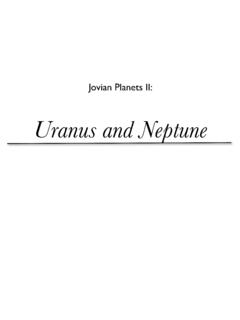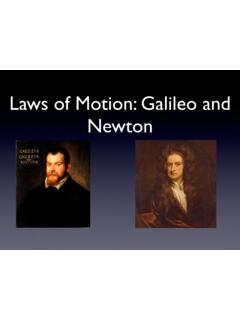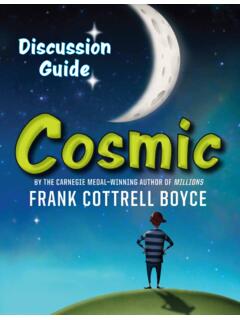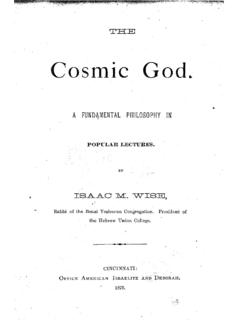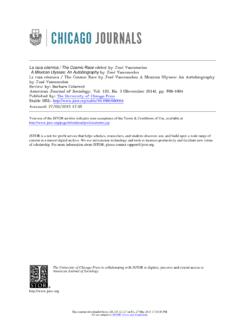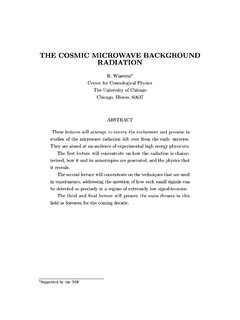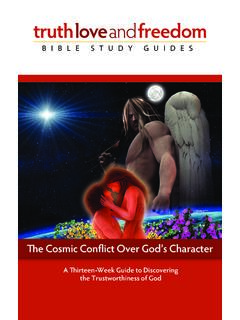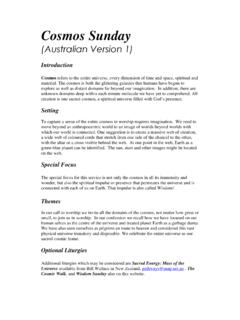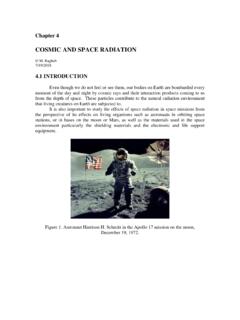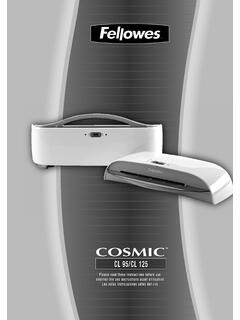Transcription of Lab 7 Hubble’s Law and the Cosmic Distance Scale
1 Lab 7 Hubble s Law and the CosmicDistance IntroductionThere are tens of satellites (moons) orbiting the planets ofthe solar system, a handful ofplanets in orbit around the Sun, and over one hundred billionstars like the Sun which makeup our Milky Way galaxy. As we advance from satellites to planets to stars to galaxies wenote that the masses and sizes of the bodies grow tremendously, as do the distances betweenthem. How can we measure large distances in the Universe?We can bounce radar signals off of solar system objects to find out how far away they liefrom Earth, and use parallax measurements to find the distances to nearby stars (takingadvantage of their apparent movements across the sky as the Earth changes its positionaround the Sun).
2 Parallax measurements have been extended to stars out to 500 light-yearsby the Hipparcos satellite (and may be pushed out to 30,000 light-years, if the planned Gaiamission succeeds). Parallax is an excellent technique for mapping the distribution of starswithin our Milky Way galaxy but how can we chart the rest of the Universe?As the 20thcentury began many astronomers thought that everything observed throughtelescopes, including the numerous spiral nebulae like the famous faint swirl in the con-stellation Andromeda, was contained within our Milky Way galaxy. Others argued thatspiral nebulae were separate galaxies, lying far beyond theMilky Way. The issue came to ahead in the famous Shapley-Curtis debate of 1920, illustrating the need for deeper, higherresolution observations to answer the question.
3 Edwin Hubble soon showed that the observ-able Universe extends far beyond the Milky Way. He used new techniques to measure thedistances to distant objects, employing Cepheid variable stars as standard candles .1An entire family of Distance determination methods is based on the concept of a standardcandle. Simply put, if we can can identify a class of objects with near-identical propertiesthen those which appear the smallest and faintest must lie furthest away from us. If you haveever gauged the Distance to an approaching car at night from the brightness of its headlights,you ve used this technique! We assume that the brightness ofthese objects obeys an inversesquare law, being inversely proportional to the square of the Distance (F 1/d2), and thattheir apparent size varies inversely with Distance ( 1/d).
4 If your standard candle is a100-watt light bulb, for example, then if it shifts to a position twice as far away from you itwill appear one-fourth as bright (like a 25-watt bulb would at its initial position).Cepheid variable stars are important examples of standard candles, used to determine accu-rate distances to stars within the Milky Way and within nearby galaxies like the Andromedagalaxy. The amount of light output by these massive stars canvary by a factor of two orthree, over a regular period of time extending from a few daysto a few months. In 1908,Henrietta Leavitt discovered that this period of variability was determined by the intrinsicluminosity of the star the more energy the star pumped out, the longer it took to varyfrom bright to faint and back to bright again, like clockwork.
5 The brightest of these starsare 10,000 times more luminous than the Sun, so they can be seen from quite a modern telescopes, we can observe Cepheid variable stars out to 30 megaparsecs (Mpc),or 100 million light-years. This allows us to determine distances to galaxies hosting such starswhich lie within 30 Mpc of the Milky Way, covering a number of nearby isolated galaxies,groups of galaxies, and even the closest large galaxy clusters like Virgo, containing hundredsof galaxies. Thirty megaparsecs might seem like a large Distance (equal to 300 times thesize of the Milky Way), but in the grand scheme of things it barely covers our own can employ this technique at larger distances by finding brighter standard candles, inthe form of supernovae.
6 Type Ia supernovae are stars which (for a brief period of time)can be as bright as an entire galaxy. They occur as part of the end-state process for low-mass white dwarf stars, when mass accreted from a stellar companion (a second star) fuelsa short, immense explosion. These objects consistently achieve a known peak luminosity,and thus when we observe them we know how far away they lie. (As they are all the sameintrinsic brightness, the further they lie from Earth the fainter they appear.) The mostdistant supernovae studied lie an amazing 1,700 Mpc away from explosions are wonderful probes of the distant Universe, but they are rare andcan be difficult to find. We thus employ additional techniques to measure the distances tomany galaxies, taking advantage of the known properties of the galaxies themselves.
7 We willexplore some of these techniques within this laboratory exercise. Within large clusters ofgalaxies (home to hundreds or even thousands of galaxies), one almost always finds a brightelliptical galaxy in the center of the cluster. These brightest cluster galaxies (BCGs) haveremarkably consistent intrinsic properties. Because theylurk in the cores of clusters andconsume unwary interlopers (yes, it s a dog-eat-dog world,and large galaxies are literallycannibals), they tend to grow to a certain size and give off a certain amount of galaxies exhibit uniform properties, meaning that they are they appear to be thesame size and emit the same amount of energy when viewed from the same Distance . (Theyare standard candles in a sense, but they vary too much to truly deserve the name.)
8 Youmight think of them as sub-standard candles built in a galactic factory, one with no routineinspections or quality controls.)We will also estimate distances to galaxies using a cosmological method based on a discoverymade by Edwin Hubble in 1930. While determining the distancesto nearby galaxies, herealized that the derived distances correlated with another observable property the velocityat which the galaxies appeared to recede. Hubble plotted recessional velocityvas a functionof distanced, as shown in Figure , and discovered that the most distantgalaxies arealso moving the fastest. We call this relationship Hubble s Law, and these diagrams Hubblediagrams, to honor his : Hubble diagram showing Edwin Hubble s original data set (left), and moderndata (right) extending out to larger distances.
9 Thex-axis shows the distances to nearbygalaxies determined by a variety of methods, and they-axis shows their recessional slope of a line fit to the data has units ofyoverx, or km sec 1per Mpc, and is calledthe Hubble constant (H0).We interpret these recessional velocities as evidence thatthe entire Universe is expandingoutward (the distances between all galaxies increases withtime). We do not assume that weare situated at the center of the Universe and everything is moving away from us, havinglearned from our previous the Earth is the center of the world phase (so 16thcentury).We can fit the slope (the change inyover the change inx) of the data in Figure , and findthe relationship between distancedand velocityv. We call this slope value H0(the Hubbleconstant) in honor of Edwin Hubble, whereH0=vd,and sov=H0d.
10 ( )3 The current accepted value of H0is 72 km sec 1per Mpc. We can also solve this equationford, so if we know the velocityvof a nearby galaxy, then it lies at a distancedsuch thatd=vH0.( )We will examine several Hubble diagrams in this laboratory exercise, determining the dis-tances to galaxies by measuring changes to their spectra dueto recessional GoalsThe primary goals of this lab are to appreciate that the Universe is expanding, and tounderstand and evaluate various techniques for determining distances to MaterialsAll online lab exercise components can be reached from the GEAS project lab will also need a computer with an internet connection, and a calculator (or calculatorapp). Primary TasksYou will study Hubble diagrams based on Cepheid variable stardata and Type Ia supernovaeobservations.
